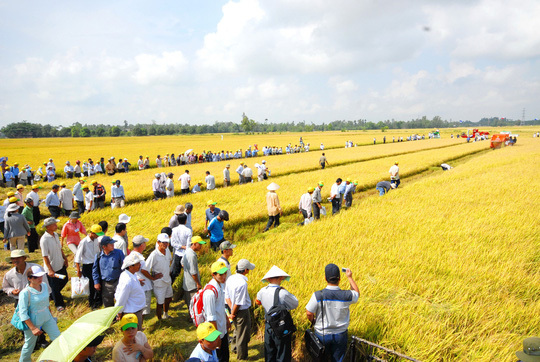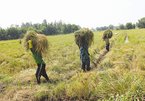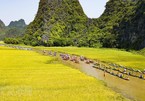Large-scale field model, a product of cooperation between agriculture enterprises and farmers, initiated by the agriculture ministry, has been implemented on a trial basis in Mekong River Delta provinces since the summer-autumn crop in 2011.

The total area of large-scale fields was reported reaching 20,000 hectares by the 2011-2012 winter-spring crop. The area increased to 26,000 hectares in the 2012 summer-autumn crop, or three times higher than 2011, to 146,000 hectares in 2014 and 196,000 hectares.
Witnessing the rapid expansion of large-scale fields, analysts then said ‘large scale fields are booming’. They also predicted that it would help change the face of agriculture, because only concentrated production in large scale could bring new value chains to agriculture.
Dong Thap province, one of the biggest rice producers in the ‘rice granary’ of Mekong River Delta, pioneered the large-scale field model.
The provincial agriculture department said that with the appearance of modern large-scale rice fields, the production technique of cooperatives has improved significantly. Since rice production is now mechanized, productivity and quality have been upgraded significantly.
However, the development of the model has unexpectedly slowed down in recent years. A report of the Plantation Agency under the agriculture ministry said the Mekong Delta had 170,000 hectares of large-scale rice fields in the 2017-2018 winter-spring crop, just 10 percent of total rice fields at the same time (1.68 million).
|
The provincial agriculture department said that with the appearance of modern large-scale rice fields, the production technique of cooperatives has improved significantly. Since rice production is now mechanized, productivity and quality have been upgraded significantly. |
According to Hoang Trung Kien from Kien Giang Agriculture Expansion Encouragement Center, the center developed five large-scale fields (2,237 hectares) in the 2018-2019 winter-spring crop.
In addition, provincial farmers also joined forces with enterprises to cultivate on 22 large-scale fields more (20,000 hectares). However, the 22.237 hectares was modest if compared with the total area of 289,000 hectares of rice fields.
Pham Thai Binh, director of Trung An Hi-tech Agriculture JSC, said large-scale field is a very effective production model, but it still cannot develop because enterprises lack capital.
“Commercial banks refuse to provide loans, or they disburse capital in dribs and drabs,” he said, adding that at first, the company had 8,000 hectares of large-scale fields, but the area has shrunk to 5,000.
Meanwhile, Nguyen Van Hinh from An Giang Rural Development Sub-department, said though farmers can see the strong points of the large-scale field model, they still lack confidence. In many cases, farmers don’t strictly follow the technical procedures set by enterprises, thus affecting output and consumption.
Vo Tong Xuan, rector of Nam Can Tho University, said farmers, who are used to small-scale production, should ‘think big’ and cooperate with enterprises to organize production on a large scale for bigger profits.

Rice production in Vietnam's Mekong Delta took wrong path: expert
While the entire society was still in dreaming of being a rice export power, farmers were realistic, realizing that the higher the yield of rice, the lower profit they would get because of higher fertilizer and pesticide costs.

Alluring Tam Coc in ripe rice season
A tourism week is taking place in Tam Coc, Ninh Binh province, aiming to promote tourism in the locality during the summer when rice fields turn bright yellow and look majestic, romantic and poetic.
TBKTSG
 The large-scale field model has developed more slowly after a boom period.
The large-scale field model has developed more slowly after a boom period.